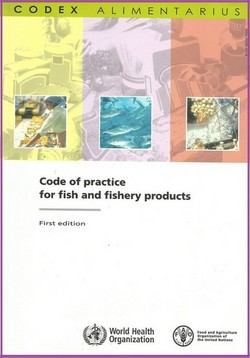Code of Practice for Fish and Fishery Products
First Edition - Rome 2009
Introduction
This Code of practice for fish and fishery products has been developed by the Codex Committee on fish and fishery products from the merging of the individual codes listed in Appendix 12¹ plus a section on aquaculture and a section on frozen surimi. These codes were primarily of a technological nature offering general advice on the production, storage and handling of fish and fishery products on board fishing vessels and on shore. This Code also deals with the distribution and retail display of fish and fishery products.
This combined Code of practice has been further modified to incorporate the Hazard Analysis Critical Control Point (HACCP) approach described in the recommended international code of practice- general principles of food hygiene (CAC/RCP 1-1969), Annex: “Hazard Analysis and Critical Control Point (HACCP) system and guidelines for its application”. A prerequisite programme is described in the Code covering technological guidelines and the essential requirements of hygiene in the production of fish, shellfish and their products that are safe for human consumption, and otherwise meets the requirements of the appropriate Codex product standards. The Code also contains guidance on the use of HACCP, which is recommended to ensure the hygienic production of fish and fishery products to meet health and safety requirements.
Within this Code, similar systematic approach has been applied to essential quality, composition and labelling provisions of the appropriate Codex product standards. Throughout the Code, this is referred to as “defect action point (DAP) analysis” However, DAP analysis is optional.
The Codex Committee on fish and fishery products recommended at its Twentieth Session that defects of a commercial nature, i.e. workmanship defects, which had been removed from Codex fish product standards, be transferred to the appropriate Codex Code of practice for optional use between buyers and sellers during commercial transactions. The Committee further recommended that this detail should be described in a section on final product specifications, which now appear as Appendixes 2-11¹ of this document. A similar approach to HACCP has been incorporated into the Code as guidelines for the control of defects (DAP analysis).
This Code will assist all those who are engaged in the handling and production of fish and fishery products, or are concerned with their storage, distribution, export, import and sale in attaining safe and wholesome products that can be sold on national or international markets and meet the requirements of the Codex Standards (see Appendix 12¹).
Contents:
Section 1: Scope
Section 2: Definition
Section 3: Prerequisite Programme.
Section 4: General Considerations for the Handling of Fresh Fish, Shellfish and other Aquatic Invertebrates.
Section 5: Hazard Analysis and Critical Control Point (HACCP) and Defect Action Pint (DAP) Analysis.
Section 6: Aquaculture Production.
Section 7: Live and Raw Bivalve Molluscs.
Section 8: Processing of Fresh, Frozen and Minced Fish.
Section 9: Processing of Frozen Surimi
Section 10: Processing of Quick- Frozen Coated Fish Products.
Section 11: Processing of Salted and Dried Salted Fish.
Section 12: Smoked Fish
Section 13 A: Lobsters
Section 13 B: Carbs
Section 14: Processing of Shrimps and Prawns
Section 15: Processing of Cephalopods.
Section 16: Processing of Canned Fish, Shellfish and other Aquatic Invertebrates.
Section 17: Transportation
Section 18: Retail




ساحة النقاش